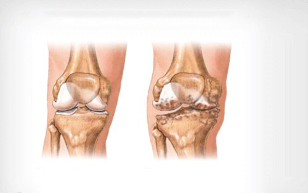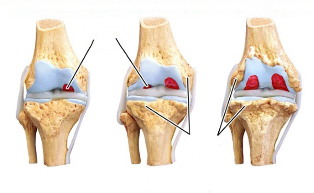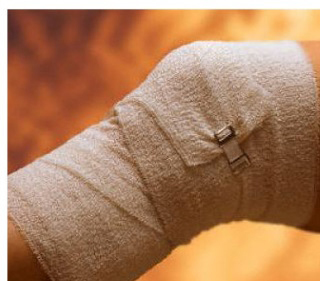Osteoarthritis of the knee joint (also called gonarthrosis) is a damage to the knee joint that results in the destruction of articular cartilage, deformity of the knee, and limited knee movement. The article will help you to learn the symptoms and start the necessary treatment in time.
Osteoarthritis of the knee joint
Experts divide gonarthrosis into primary and secondary forms:
- The cause of the primary form is a congenital defect of the joint, and the development of the disease occurs in childhood and adolescence.
- The secondary form can develop at any age.

Experts call the main causes of the disease:
- weak posture;
- overweight;
- various types of knee injuries;
- disorders of mineral metabolism and metabolism;
- presence of endocrine diseases;
- increased stress on the knee joints;
- Disorders of calcium metabolism due to taking hormone-containing drugs;
- meniscus removal operations;
- presence of arthritis;
- weak garden apparatus;
- Menopause and menopause in women.
Osteoarthritis of the knee joints can be bilateral or unilateral.
Stages and symptoms of osteoarthritis
Depending on the symptoms and approach to the disease, experts divide the disease into 3 stages.
Early or stage 1 osteoarthritis
At this stage, mild pain appears with increasing stress on the knee.The initial phase can last from 1 to several years.To prevent the scene from becoming more severe, a number of measures must be taken to restore the deformed cartilage, strengthen the ligaments, and restore movement in the knee.
At this stage, timely treatment will completely get rid of the pathology. However, most patients ignore the symptoms in the form of mild pain and therefore do not consult a doctor. Knee osteoarthritis is treated by an orthopedist, rheumatologist or surgeon.
Middle or second stage of osteoarthritis

At this stage, the symptoms of the disease are more pronounced, and therefore it is impossible to ignore them. Doctors note that most of the patients seek medical help in stage 2. An accurate diagnosis can be made at this stage. Timely treatment allows to stop the progression of the disease to the 3rd degree.
Severe symptoms include:
- painful knees with hypothermia;
- the presence of a mild crisis;
- swelling or swelling in the knee area;
- severe knee pain that increases when climbing stairs or other stresses;
- calf pain and tingling;
- Stiffness in knee flexion and extension.
The last or 3rd stage of osteoarthritis
At this stage, the consequences of the disease are irreversible, it is impossible to stop the development of pathology. However, treatment will ease the patient's condition for a while. Under no circumstances should you ignore the symptoms or self-medicate, as this may cause gait changes, walking with a cane, or disability.
In addition to the above, doctors refer to the main symptoms of stage 3:
- endocrine system pathology (thyroid gland, diabetes problems);
- hereditary and age factors.
Diagnostic methods

The specialist makes a diagnosis based on the patient's words and the results of laboratory and instrumental studies.
Laboratory tests include:
- complete blood count.With the help of research, you can determine the cause of the disease and assess the degree of inflammation.
- general urinalysisallows to determine or exclude the autoimmune origin of the disease, to assess the source of renal and urinary tract pathology. The
- biochemical blood test, which is divided into others, shows that the results of almost all studies are above normal.
Laboratory tests are performed during the exacerbation of the disease, as all indicators are normal during remission.
Instrumental research is:
- x-ray.It is performed in two projections - back-front and lateral. Generally, the doctor takes a picture of both knees to compare the affected and healthy knees.
- arthroscopy.This procedure should be understood not only as research, but also as a mini-operation. The truth is that the doctor places a small LED conductor through a small hole in the knee and a complete picture of the internal condition of the knee is displayed on a computer screen, the pieces of tissue are sent to the laboratory if there is a suspicion of cartilage or malignancy. It is possible to endoscopically correct the shape of the meniscus, remove polyps and chondrophytes. In addition to the diagnosis of osteoarthritis, other diseases can be diagnosed and examined, because the knee joint is a large organ and allows you to get complete information about the condition of the body.
- Ultrasound(ultrasound).This method of examination has two important advantages over X-rays - it is harmless and helps to see the soft tissues of the joint due to its wide field of vision.
- CT (computed tomography).Research is an improved form of radiography, because during the procedure, the doctor takes several pictures and creates a three-dimensional image of the affected organ on a computer. This form is less used than others due to time costs and large amounts of radiation.
- MRI (magnetic resonance imaging).It is more harmless than the previous method. In addition, MRI allows you to get a better image of soft tissues compared to CT. However, MRI is used as rarely as CT, because its use requires high material costs and can not be applied to patients with metal objects (tissue needles, crowns). CT and MRI are contraindicated in people over 120 kg.
 scintigraphy.An expensive and radiation-related method. Therefore, less expensive methods are used in cases where they are ineffective. In this study, a substance that reacts to the patient's body and is localized around it is injected into the patient's body.
scintigraphy.An expensive and radiation-related method. Therefore, less expensive methods are used in cases where they are ineffective. In this study, a substance that reacts to the patient's body and is localized around it is injected into the patient's body. - tomography.The research is based on thermal radiation from the body's surface. In general, the affected organ manifests itself in the form of a focus with increasing temperature. The tomograph is a difficult tool, and because the procedure is expensive, this study is performed only in large clinics.
Medications to treat and relieve symptoms
Experts say that it is impossible to start treatment without relieving pain and inflammation.That's why doctors prescribe a variety of non-steroidal (non-hormonal) medications. However, you can not take them longer than the prescribed period, because this group of drugs does not cure the disease, but rather eliminates the symptoms, and during this period the disease progresses.
Ointments for osteoarthritis
Treatment of osteoarthritis of the knee joint with symptoms of edema and pain is rarely carried out without ointment.
Unlike other forms of drug release, this group has clear advantages:
- quickly reduces pain and inflammation;
- ease of use, facilitates combination with other treatments such as physiotherapy;
- has no adverse effects on the liver.
Gymnastics for osteoarthritis

Gymnastics is one of the important methods in the treatment of osteoarthritis of the knee joint, which should be used in remission after the elimination of pain symptoms.
Contributes:
- Improve articular cartilage nutrition and overall health:
- painkiller;
- strengthen the muscles and ligaments of the knee joint;
- Increased joint mobility.
To see the positive effects,should be done daily or every day by increasing the exercise load to 30 minutes.
- Warming up. You need to walk on tiptoes or heels for 3-5 minutes.
- Pedal the imaginary bike 20-30 times (10-15 times with each foot).
- Lie on your stomach, bend your knees 10-15 times and straighten. Hold the foot in this position for 5 seconds on each turn.
- Lie on your back and stretch your legs. Lift your legs and bend at the knees. The heel should be parallel to the floor.
- Lie on your right side, lift your left leg, pull on your abdomen, and then pull back as much as possible. Move to the other side and repeat the exercises. Repeat 5-6 times for each leg.
Sports should be avoided if:
- hernia of the abdomen or hips;
- cardiovascular diseases;
- infectious diseases;
- blood diseases;
- postoperative rehabilitation period.
Rubs and squeezes

Various rubs and compresses are widely used in the treatment of osteoarthritis. Their significant advantages include the presence of substances and the absence of side effects.
- Garlic.Pour 1 head of vegetable oil with any vegetable oil (200 ml), cover and keep in a dark and cool place for 7 days. Then wash the product overnight. To eliminate the special odor, cover the knee with a thick gauze bandage and rinse thoroughly with water in the morning.
- Eggs. Mix vinegar with 1 yolk 1: 1 and immediately rub a little on your knee. Apply 3 times a week. After rubbing, wrap the knee in something warm.
- Bal.Mix 100 grams of honey and 3 grams of mummy and apply immediately on your knees. Wrap your knee.
- Cabbage.Soak a piece of wool in the juice of a vegetable and stick it on the knee.
- Oatmeal.Boil 1-2 tablespoons of regular porridge in shell water. Do not boil the flakes for more than 7 minutes! Place the viscous product on a clean cloth and apply to the knee.
sarar
Osteoarthritis of the knee joint (symptoms and drug treatment are described above), according to experts, can be treated with different types of sprains. The most effective are honey and herbs.
According to research, honey shells help:
- to restore tissues and intra-articular cartilage destroyed by disease;
- relieve pain and inflammation;
- Burn excess cholesterol.
It should be noted that honey is most effective when combined with cinnamon.
When it comes to herbal wraps, the above features:
- willow, oak, maple, maple bark;
- valerian, comfrey, burdock roots;
- hop, maple, nettle leaves;
- wild rosemary and St. John's wort herbs;
- chamomile flowers, calendula.
Treatment of knee osteoarthritis with hirudotherapy

One of the most effective ways to treat knee osteoarthritis is hirudotherapy. It can be used at the first symptoms and should be directed by the attending physician and under the supervision of specialists. You should read the contraindications before the first procedure.
Don't use leeks:
- children and the elderly;
- patients with decreased blood clotting, hypotension, severe fatigue, leukemia, anemia, gastrointestinal erosion, gastric ulcer, digestive problems, cancer, tuberculosis, anemia and hemophilia;
- Women during pregnancy and lactation.
For treatment to be effective, 1-2 procedures should be performed every 5-6 months.Treatment can be more or less frequent - it all depends on the stage of the disease. If the patient feels better after 1-3 sessions and does not show an allergic reaction, then leprosy treatment can be continued.
Otherwise, the patient is given a break of 9 months, and if the allergy reappears or does not improve, hirudotherapy sessions are stopped. During the treatment, the specialist treats the knee with an odorless tool and then inspects the leeches to be used for compliance.To do this, the leeks are placed in a bowl with water. If the leech sticks to the walls, then it can be used. The specialist puts 2-6 leeks on the patella.
Leeches release a number of beneficial enzymes that help the human body absorb:
- restore and strengthen the immune system;
- restoration of blood circulation and metabolic processes;
- Eliminate swelling and adhesions.
Hirudotherapy cannot be used as a separate treatment. For greater effectiveness, experts recommend combining it with physiotherapy, physiotherapy exercises and medication.
take turpentine and pine baths

Balneotherapy, ie taking various baths with therapeutic effect, is not the last place to eliminate the symptoms of osteoarthritis.Experts note that there are different types of therapeutic baths, but turpentine and pine baths have shown special effectiveness. They can be taken not only in balneological resorts, but also at home.
But despite the benefits, they should be discarded:
- patients with heart disease;
- oncological diseases, tuberculosis, varicose veins, diabetes, epilepsy, atherosclerosis, arterial hypertension,
- if the patient had a heart attack or stroke;
- in case of skin diseases;
- For pregnant women.
For the turpentine bath, mix 10 grams of baby soap, 0. 75 ml of salicylic acid and pour the mixture with 500 ml of boiling water. As the mixture cools, you should fill the tub with hot water. When the mixture has cooled to 45 degrees, add turpentine and pour 15-20 ml of the mixture into the bath.
Due to the presence of turpentine, the temperature in the bath may appear to be elevated.Therefore, you should not increase the dose by more than 20 ml at a time. Baths should be taken daily for 10-14 days, in one procedure the dose of turpentine mixture should be gradually increased to 80 ml. After taking a bath, wash the mixture with warm water and put on warm clothes or lie down under a blanket.
You need candle needles or twigs for candle baths. About 25-30 twigs need to be cut into small pieces to fit in the pot. Before preparing the broth, wash the twigs, float, pour water and cook for 5-10 minutes. Strain the prepared broth and pour into a hot water bath.
Bathe for 10-15 minutes.Then dry and put on warm clothes. It is not recommended to engage in physical labor and load the knees. The course of candle bath treatment may include 7-12 procedures that can be taken daily or every other day. The course can be repeated after six months. This procedure will prolong the remission period and stop the development of the disease.
Use of chondroprotectors
Osteoarthritis of the knee joint (symptoms and treatment with folk remedies are given below) cannot be treated without chondroprotectors - a group of drugs aimed at restoring cartilage tissue and nutrition. All drugs in this group are divided into 5 groups. Drugs for the treatment of osteoarthritis belong to 4 groups.
These are based on:
- glucosamine;
- chondroitin sulfate;
- avocado and soy extracts;
- hyaluronate and hyaluronic acid;
- Synthesis of glucosamine and chondroitin sulfate.
Chondroprotectors are prescribed by specialists in combination with pain medications.But unlike the latter, the former must be taken for life, because only in this case it is possible to slow the development of osteoarthritis and stop the disability. The effect of taking chondroprotectors is visible only after 2-8 days.
Medications are available in the form of gels, ointments, tablets and injections. An injection is made through a solution into the knee.
Diet: what foods are allowed, nutrition rules and approximate diet

Being overweight has a negative effect on the development of osteoarthritis - the disease develops faster than in patients of normal weight. For this reason, overweight people are advised to lose extra pounds. But at the same time, it is absolutely impossible to starve and sit on mono-diets or diets with dietary restrictions.
Permitted products include:
- Hormone-free farm meat that can be boiled, cooked, baked or steamed. If you do not have access to farm meat, you can buy ordinary meat, but you need to get rid of the skins and fat, because all the harmful substances that are fed or injected into animals or birds accumulate there. It is better to limit the consumption of such meat 1-2 times a week, and the rest of the time there are vegetable or fish dishes.
- Fruits and vegetables cooked or cooked to your taste.
- all types of cereals (excluding ready-made grains).
- pectin products: currant, jelly on fructose;
- fermented dairy products;
- egg;
- Wholemeal bread and pasta.
It is important to exclude from the diet:
- baked goods, sweets and white bread;
- alcoholic beverages and beer;
- various types of fast food and snacks;
- sausages and other ready-made meat products.
With osteoarthritis, 1200 Kcal should be consumed daily.It is necessary to eat in fractions, ie in small portions every 2-3 hours.
Folk remedies
Knee osteoarthritis, symptoms and treatment can be easily done with traditional medicine:
- If osteoarthritis is accompanied by edema, a blue clay compress will help. To do this, dilute the clay with water to a creamy state and put it on a tight cloth folded 4-6 times and close the joint. Wrap the knee with gauze or other cloth to prevent the compress from slipping. Leave on for 2-3 hours and rinse with warm water. The fabric can be washed and reused.
- Experts advise to give up natural tea and coffee and replace them with decoctions and infusions. For example, a lingonberry decoction. 2 teaspoons for him. need to pour 1 liter of berries. Leave for an hour wrapped in boiling water and a towel. You need to drink 3-4 times a day.
- Massage ointment will help to get rid of pain and inflammation at any stage of the disease. To do this, mix 50 grams of petroleum jelly, 10 grams of chopped hops, sweet clover and St. John's wort. You need to insist the product for 2-3 hours in a dark place. Rub with light massage movements. You can bend your knee.
How long is the rehabilitation period
It is impossible to say unequivocally how long the rehabilitation of osteoarthritis will last, because the time depends on various factors. For example, the patient's age and lifestyle, the degree and severity of the disease.
Generally, the recovery period lasts 1-2 months, during which time the patient, with the help of specialists:
- eliminates inflammatory and pain syndromes;
- learns to exercise and regulates nutrition.
To prolong remission as long as possible, the patient should exercise regularly and consult a doctor. Osteoarthritis of the knee joint with the elimination of symptoms and the right approach to treatment will allow you to stay in the rhythm of normal life.



































